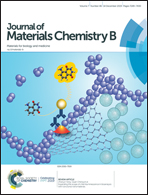Surface modification via plasmid-mediated pLAMA3-CM gene transfection promotes the attachment of gingival epithelial cells to titanium sheets in vitro and improves biological sealing at the transmucosal sites of titanium implants in vivo†
Abstract
Although titanium implants have been applied in dental clinics to replace lost teeth and to restore masticatory function for decades, strategies to design the surface of the transmucosal sites of implants to achieve ideal and predictable biological sealing following implantation remain to be optimized. In this study, we hypothesized that gingival epithelial cell (GEC) adhesion and new tissue attachment to titanium sheets/implants could be promoted by the release of plasmid pLAMA3-CM (encoding a motif of the C-terminal globular domain of LAMA3) from a titanium surface. To test this hypothesis, a chitosan/collagen (Chi/Col) coating was immobilized on the surfaces of titanium substrates with nanotube topography (NT-Ti) through cathodic electrophoretic deposition; it was found that pLAMA3-CM could be released from the coating in a highly sustained manner. After culturing on titanium with nanotube topography coated by Chi/Col with the plasmid pLAMA3-CM (Chi/Col/pLAMA3-CM-Ti), human GECs (hGECs) were found to effectively uptake the incorporated plasmids, which resulted in improved attachment, as evidenced by morphological and immunofluorescence analyses. In addition, Chi/Col/pLAMA3-CM-Ti induced better biological sealing at transmucosal sites following immediate implantation into Sprague-Dawley rats. Our findings indicate that the modification of titanium implants by plasmid-mediated pLAMA3-CM gene transfection points to a practical strategy for optimizing biological sealing around the transmucosal sites of implants.



 Please wait while we load your content...
Please wait while we load your content...